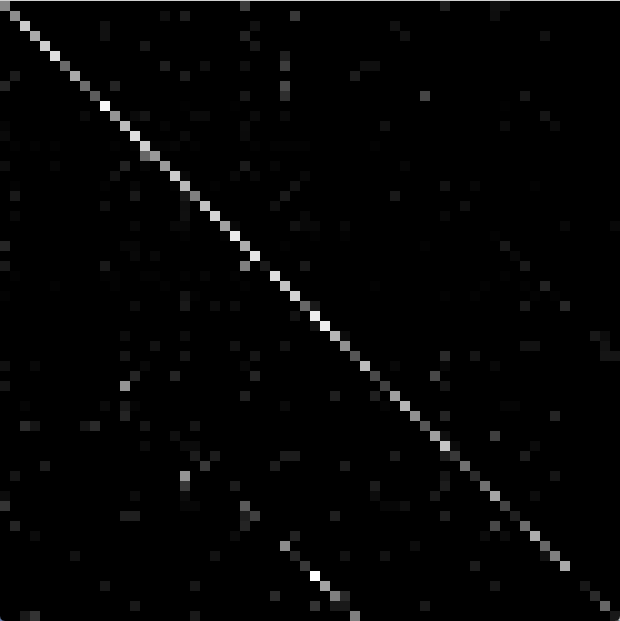This is a model for classifying the "EnglishImg" part of the Chars74K dataset.
All the images are of different shapes and sizes. Several methods were tried to bring all the images to a common shape for training.
- Both 128x128 and 64x64 dimensions were tried; there wasn't much of a performance gain while using 128x128 so 64x64 was kept for faster training
- I tried keeping the aspect ratio of all images but that meant black bars had to be either side of the image, or above and below. Stretching the images actually helped towards getting better results overall.
- At first, the images were passed to the network in RGB but it was changed to grayscale as it didn't affect accuracy and grayscale might allow for better generalisation. This also meant faster training.
- The RGB image is normalised channel-wise before being converted to grayscale.
The original dataset was split randomly the following way :
- 60% training set (4623 samples)
- 20% validation set (1541 samples)
- 20% test set (1541 samples)
A convolutional neural network was chosen because they are known to perform well for this type of problem.
- The baseline model was composed of a conv layer with 32 feature maps, 8x8 kernels and a 2x2 stride, followed by a fully connected layer and a softmax cross entropy loss. It obtained 43% accuracy on the validation set.
- Adding a second convolutional layer (with the same parameters as the first one except for 4x4 kernels) pushed the accuracy to 60%.
- A third convolutional layer also helped improving the accuracy but by a small margin only.
- Increasing the number of feature maps in the second and third layer to 64 and 128, and adding a hidden layer of 512 units just before the last fully connected layer pushed the performance to 65%.
- Dropout had been tried in several settings for the above architectures but didn't improve the results.
- Same had been done for pooling layers.
I did some reading up on rules of thumb when designing convnets and rewrote the network as follows:
Conv1 : 3x3 kernels | 1x1 stride | 32 maps | relu
Conv2 : 5x5 kernels | 2x2 stride | 64 maps | relu
Conv3 : 5x5 kernels | 2x2 stride | 128 maps | relu
Max Pooling : 2x2 kernels | 2x2 stride
Fully Connected : 512 units | relu
Dropout (0.8)
Fully Connected : 62 units | softmax
This network gave the best results on the validation set at 71.7%.
The performance obtained and discussed below are not state-of-the-art (this guy claims for example to reach 86% accuracy). This is because the scope of this challenge, I believe, was not to try to get extremely close to it but rather to show a work flow and structure. However, here are a couple of ideas to improve performance further :
- The dataset is quite small (less than 10K images). Data augmentation could help towards better generalisation (affine transformations on images, using the computer generated characters available in the original dataset, using GANs, ...)
- There are probably far better architectures, making better use of dropout, convolution and max pooling than the one presented here.
The metric used is the percentage of correct predictions since this is a balanced multi-class prediction problem and we only care about whether we predicted the right caracter or not. The chance level is at 1.61%.
The final test set accuracy is 69.3%. This result is quite close to the validation set accuracy (71.7%).
The confusion matrix shows quite good performance, but we can also see parallel lines to the diagonal; these lines correspond to the lowercase/uppercase equivalent of the letter. (The y axis shows ground truth, and each row is normalised, and the x axis shows predictions. The order of the classes, top to bottom, is : digits, uppercase, lowercase).
An interesting metric is the case insensitive accuracy, which is 75.8%. More than 5% of the predictions are correct but miss the case.
A more informal metric is the top 3 accuracy : how many times is the correct label in the top 3 predicted classes? This happened 86.5% of the time in the test set.
Prediction occured at more than 100FPS on a quad-core 2,3GHz Intel Core i7.
Here are randomly selected examples of errors in the test set classification. Characters which were correctly predicted but had the wrong case prediction were ignored on purpose.
As you can see, some samples are of very bad quality (heavy distortion, zoom or rotation), and some confusions can be understood (the cropped o being interpreted as an 'n', the 'B' which has a similar structure as an 'E',...)
The requirements are python3, OpenCV and the requirements written in
requirements.txt (run pip install -r requirements.txt)
# run the dataset split (the English directory should be downloaded first)
python preprocessing.py English -s datasplits/good
# prepare directories for training
mkdir saves summaries
# run training
python train.py -t datasplits/good_train -v datasplits/good_validation -m saves/awesome_model
# run testing
python test.py -d datasplits/good_test -m saves/following_conventions-25000


